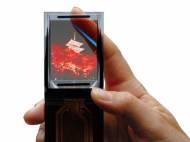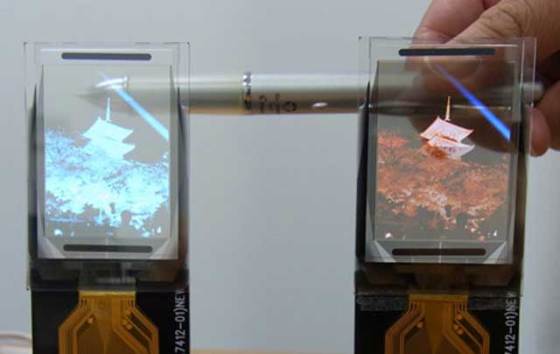See-through organic electroluminescent display to be mass produced by TDK
 In our previous articles we wrote about a variety of see through displays, and TDK Corporation has started mass production of a newly developed see-through display. Based on a passive matrix type Quarter Video Graphics Array (QVGA) organic electroluminescent (EL) display, its main application will be focused onto mobile phones and other small mobile electronic devices.
In our previous articles we wrote about a variety of see through displays, and TDK Corporation has started mass production of a newly developed see-through display. Based on a passive matrix type Quarter Video Graphics Array (QVGA) organic electroluminescent (EL) display, its main application will be focused onto mobile phones and other small mobile electronic devices.
TDK started developing organic electroluminescent materials two decades ago, establishing an in-house R&D framework covering the entire process from molecular structure design to chemical composition and device evaluation. Through time, they developed a long-life material and thin film layer configuration, as well as an optimized mass production process. Development of a white organic EL element was started in 1995, culminating in a final product in 2000.
The use of the color filter principle means that the service life of the each Red, Green and Blue color of RGB elements is identical, and color shift is absent. Furthermore, favorable temperature characteristics allow a wide operating temperature range from -20 to +85°C.
Organic EL displays are formed through thin-film techniques, using organic material that emits light in response to an electric current. High brightness, wide viewing angle and other favorable characteristics make this display type very easy on the eye, and since it also achieves fast response, Organic EL displays have been adopted for wider use in flat panel displays. All organic EL displays from TDK use the passive matrix principle.
Passive matrix drive principle is one of the methods used to drive organic electroluminescent elements. Unlike active matrix displays which use a dedicated thin film transistor (TFT) to activate each pixel, passive matrix displays use a grid of vertical and horizontal electrode lines to activate a desired pixel.
The QVGA (which features a 320 × 240 pixel grid) display developed for mobile applications has a display area of 36 × 47.9 mm (1.4 x 1.88 inches), a field angle of 2.4 inches, transmittance of 40 percent, and brightness of 150 Cd/m2. Although it is a see-through type, the display content can’t be easily seen from behind because the display is constructed in a way to protect the user’s privacy.
Aside usability, many mobile devices rely on their design, and this sort of displays has the potential to be both eye-catching and practical. However, the problem which emerges with the use of organic EL displays is in their longevity, and researchers at TDK are working towards further improvement of precision and increased durability.










Very interesting, hope they’ll make it in larger size.
I can’t wait they implement it into ski goggles or sun glasses with these and augmented reality.
Organic electroluminescence is indeed emerging field which has great applications in Mobiles.
Dr.A.Jagadeesh Nellore(AP),India
Such transparent device application should not be just limited to mobile, but also to Automotive, Aerospace, construction equipments, shipping, etc. basically it can be used wherever there is a user behind the glass and important information is to be shared, expressed, alerted!
The application is enormous, huge business ahead! can’t wait!